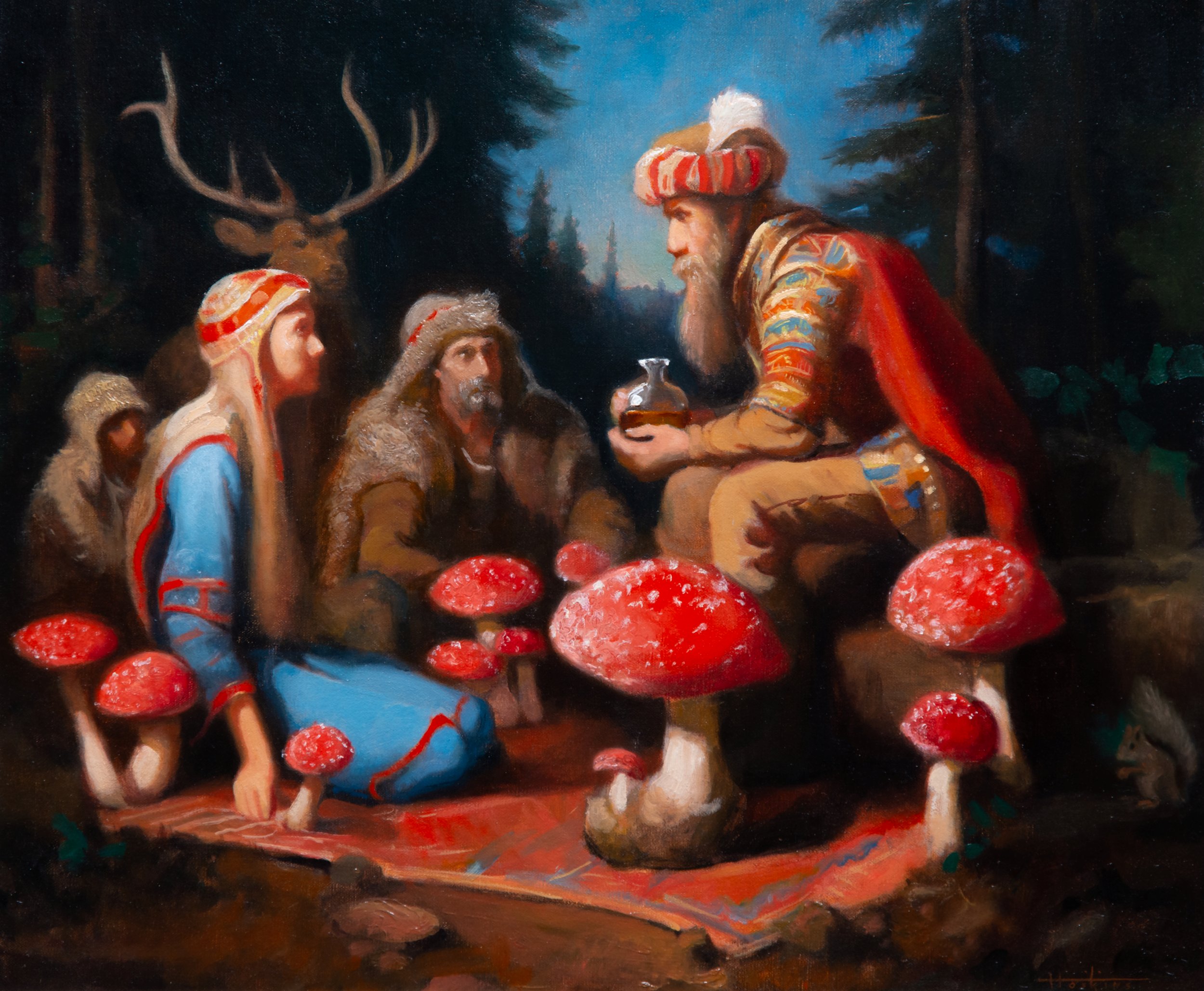Winter Solstice
20x24 Inches - Oil on Linen - 2023
The original is 20x24”, not including the size of the frame. The original painting comes with the frame included in the second photo.
There is a mysterious mushroom thriving beneath pine trees, inherently toxic yet harboring a fascinating secret. An archaic village shaman of the North Pole Samis stumbles upon a tree adorned with bright red "gifts" — an image remarkably reminiscent of the excitement on Christmas morning. Surprisingly, these toxic mushrooms, with a bit of processing, could be transformed into a mind-altering experience.
One method of detoxifying these mushrooms involved drying and hanging them over a fire, a practice that echoes the familiar sight of stockings hung by the fireplace in modern traditions. Another intriguing twist was the involvement of reindeer. These creatures, known for their love of the mushrooms, would gobble them up eagerly. Remarkably, the reindeer's digestive system was adept at filtering out toxins while also causing them to exhibit joyful leaps. The urine of these festive reindeer contained water-soluble consciousness-altering alkaloids, leading those brave enough to partake in a drink to experience intense hallucinations — most notably, the sensation of flying. Hence, the colloquial name "fly agaric" draws a clear parallel to the iconic imagery of Santa and his flying reindeer.
On the Winter Solstice, the shaman, garbed in red and white akin to the mushroom, would embark on a ritualistic journey. House to house, he would deposit this sacred gift, often navigating through snow-covered front entrances, with the chimney serving as the sole entrance and exit.
While speculative, these parallels suggest that the enchanting imagery of Christmas may have roots far deeper and older than the more recent, commercialized version epitomized by Coca-Cola's portrayal of Santa Claus. The echoes of ancient practices linger in the festive traditions we hold dear today.
20x24 Inches - Oil on Linen - 2023
The original is 20x24”, not including the size of the frame. The original painting comes with the frame included in the second photo.
There is a mysterious mushroom thriving beneath pine trees, inherently toxic yet harboring a fascinating secret. An archaic village shaman of the North Pole Samis stumbles upon a tree adorned with bright red "gifts" — an image remarkably reminiscent of the excitement on Christmas morning. Surprisingly, these toxic mushrooms, with a bit of processing, could be transformed into a mind-altering experience.
One method of detoxifying these mushrooms involved drying and hanging them over a fire, a practice that echoes the familiar sight of stockings hung by the fireplace in modern traditions. Another intriguing twist was the involvement of reindeer. These creatures, known for their love of the mushrooms, would gobble them up eagerly. Remarkably, the reindeer's digestive system was adept at filtering out toxins while also causing them to exhibit joyful leaps. The urine of these festive reindeer contained water-soluble consciousness-altering alkaloids, leading those brave enough to partake in a drink to experience intense hallucinations — most notably, the sensation of flying. Hence, the colloquial name "fly agaric" draws a clear parallel to the iconic imagery of Santa and his flying reindeer.
On the Winter Solstice, the shaman, garbed in red and white akin to the mushroom, would embark on a ritualistic journey. House to house, he would deposit this sacred gift, often navigating through snow-covered front entrances, with the chimney serving as the sole entrance and exit.
While speculative, these parallels suggest that the enchanting imagery of Christmas may have roots far deeper and older than the more recent, commercialized version epitomized by Coca-Cola's portrayal of Santa Claus. The echoes of ancient practices linger in the festive traditions we hold dear today.
20x24 Inches - Oil on Linen - 2023
The original is 20x24”, not including the size of the frame. The original painting comes with the frame included in the second photo.
There is a mysterious mushroom thriving beneath pine trees, inherently toxic yet harboring a fascinating secret. An archaic village shaman of the North Pole Samis stumbles upon a tree adorned with bright red "gifts" — an image remarkably reminiscent of the excitement on Christmas morning. Surprisingly, these toxic mushrooms, with a bit of processing, could be transformed into a mind-altering experience.
One method of detoxifying these mushrooms involved drying and hanging them over a fire, a practice that echoes the familiar sight of stockings hung by the fireplace in modern traditions. Another intriguing twist was the involvement of reindeer. These creatures, known for their love of the mushrooms, would gobble them up eagerly. Remarkably, the reindeer's digestive system was adept at filtering out toxins while also causing them to exhibit joyful leaps. The urine of these festive reindeer contained water-soluble consciousness-altering alkaloids, leading those brave enough to partake in a drink to experience intense hallucinations — most notably, the sensation of flying. Hence, the colloquial name "fly agaric" draws a clear parallel to the iconic imagery of Santa and his flying reindeer.
On the Winter Solstice, the shaman, garbed in red and white akin to the mushroom, would embark on a ritualistic journey. House to house, he would deposit this sacred gift, often navigating through snow-covered front entrances, with the chimney serving as the sole entrance and exit.
While speculative, these parallels suggest that the enchanting imagery of Christmas may have roots far deeper and older than the more recent, commercialized version epitomized by Coca-Cola's portrayal of Santa Claus. The echoes of ancient practices linger in the festive traditions we hold dear today.


